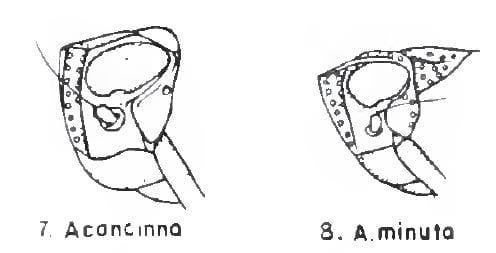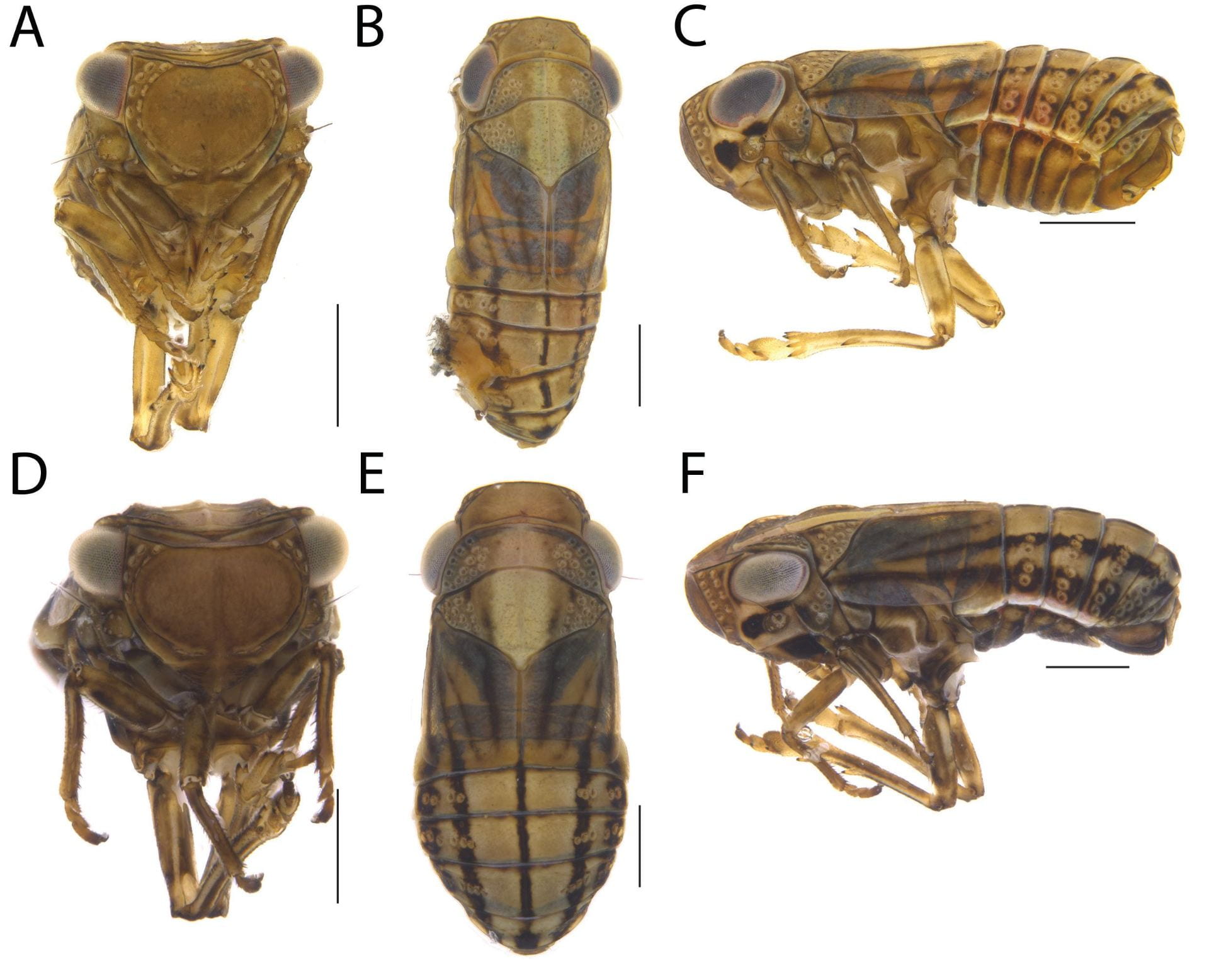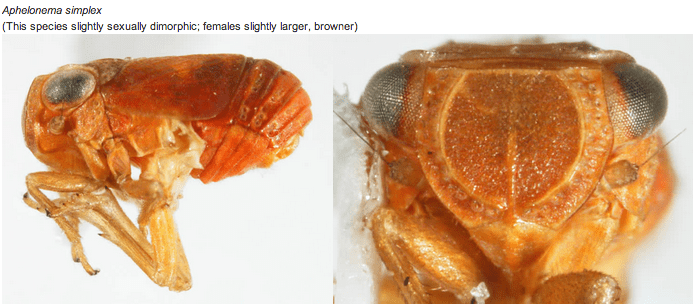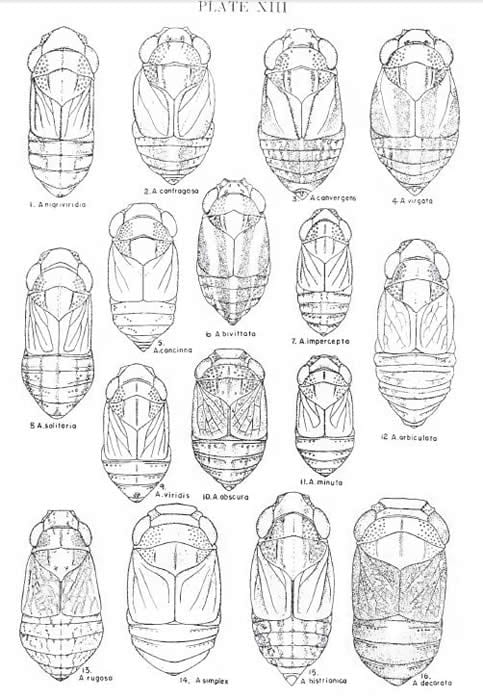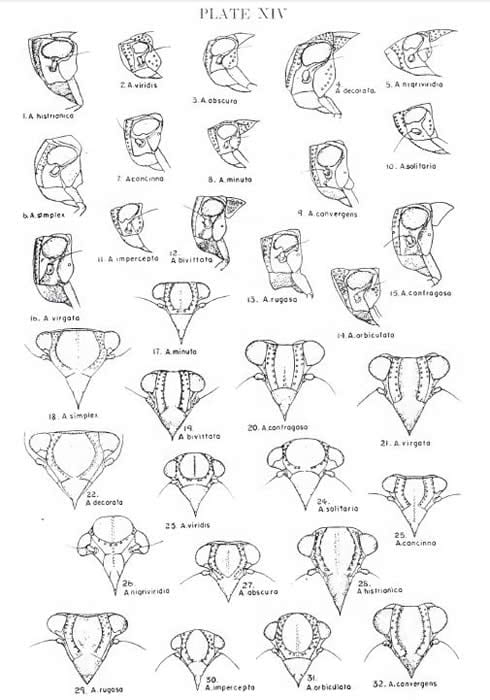[Back to “Planthoppers of North America“]
[Back to “North American Caliscelidae“]
Contents
- 1 Family Caliscelidae Amyot & Serville, 1843
Family Caliscelidae Amyot & Serville, 1843
Subfamily Caliscelinae Amyot & Serville, 1843
Tribe Peltonotellini Emeljanov, 2008
Genus Aphelonema and allies
Nenema Emeljanov, 1996 (Type species Peltonotellus bivittatus Ball 1902b)
Protrocha Emeljanov, 1996 (Type species Aphelonema orbiculata Ball, 1935)
Aphelonema Uhler, 1876 (Type species Aphelonema simplex Uhler, 1876: 356)
Synonyms of Aphelonema
= Peltonotus Mulsant & Rey 1855 (preoccupied; nec. Burmeister 1847) (Type species Peltonotus raniformis Mulsant & Rey 1855).
= Peltonotellus Puton 1886; replacement name for unavailable Peltonotus Mulsant & Rey 1855 (nec. Burmeister 1847); syn. by Melichar 1906: 36, 53; removed from syn. and redefined (subgenus) by Emeljanov 1996: 994; revised status (to genus) by Emeljanov (2008).
= Mushya Kato, 1933; syn. by Chan & Yang 1994: 8.
Distribution
Widespread in the US, Canada, and Central America.
Recognized species
Four valid species in Aphelonema. 8 in Nenema, and 12 in Protrocha.
Note: Emeljanov (1996) revised the taxonomy of Aphelonema into subgenera, which were subsequently treated as genera.
Aphelonema Uhler, 1876 (Type species Aphelonema simplex Uhler, 1876)
Aphelonema brevata Caldwell, 1945 – Mexico (Puebla, Veracruz)
Aphelonema decoratum (Van Duzee, 1908) – USA: MS, NJ, SC, FL
= Peltonotellus decoratus Van Duzee, 1908: 492, original combination
= Aphelonema decorata (Van Duzee, 1908), combination by Van Duzee (1917)
= Aphelonema (Aphelonema) decorata (Van Duzee, 1908) combination by Emeljanov (1996: 835)
Aphelonema simplex Uhler, 1876: 356 – USA: AL, CO, CT, DE, FL, IA, IL, KS, MD, MI, MO, MS, NC, NE, NJ, OH, SD, TX, VA; CAN: MB, ON, SK
= Aphelonema simplex Uhler, 1876, original combination
= Aphelonema rosa Metcalf, 1923: 188; syn. by Doering 1941: 190.
= Aphelonema (Aphelonema) simplex Uhler, 1876, combination by Emeljanov (1996: 835)
Aphelonema simplex var. dorsata Ball, 1926 – USA: FL
Aphelonema vespertina Kirkaldy, 1913: 25 – Mexico (Federal District)
Nenema Emeljanov 1996 (Type species Peltonotellus bivittatus Ball 1902b)
Nenema bivittatum (Ball, 1902) – USA: AZ, CA, CO, IA, KS, ND, NE, NM, OK, TX; CAN: AB, SK; Mexico (Chihuahua, Coahuila, Federal District)
= Peltonotellus bivittatus Ball 1902: 263; also Maw et al. 2000: 82.
= Aphelonema bivittata (Ball, 1902); comb. by Van Duzee 1916a: 80.
= Nenema bivittatum (Ball, 1902), by Gnezdilov, 2013e: 1310.
Nenema concinnum (Doering, 1941: 198) – USA: NV
= Aphelonema concinna Doering, 1941a: 198.
= Aphelonema (Nenema) concinna Doering, 1941, by Emeljanov, 1996: 835.
= Nenema concinnum (Doering, 1941), by Bartlett & Wilson, 2023: 65.
Nenema confragosum (Doering, 1941: 201) – USA: AZ, NM, NV, TX
= Aphelonema confragosa Doering, 1941a: 201.
= Aphelonema (Nenema) confragosa Doering, 1941 in Emeljanov, 1996: 835.
= Nenema confragosum (Doering, 1941) in Bartlett & Wilson, 2023: 65.
Nenema convergens (Bunn, 1930) – USA: AZ, CO, NM)
= Aphelonema convergens Bunn, 1930a: 74.
= Aphelonema convergens convergens Bunn, 1930a: 76.
= Aphelonema bivittata convergens Bunn, 1930 in Ball, 1935a: 39.
= Aphelonema convergins [sic] (Bunn, 1930) in Caldwell, 1945c: 96.
= Aphelonema convergins [sic] (Bunn, 1930) (misspelling of Aphelonema convergens Bunn, 1930) in Caldwell, 1945c: 96.
= Aphelonema (Nenema) convergens Bunn, 1930 in Emeljanov, 1996: 835.
= Nenema convergens (Bunn, 1930) in Bartlett & Wilson, 2023: 65.
Nenema convergens var. canyonensis (Bunn, 1930) – USA: AZ
= Aphelonema convergens var. canyonensis Bunn, 1930a: 76.
= Aphelonema (Nenema) convergens canyonensia [sic] (Bunn, 1930) in Bartlett, O’Brien & Wilson, 2014a: 84.
= Aphelonema (Nenema) convergens canyonensia [sic] (Bunn, 1930) (misspelling of Aphelonema convergens var. canyonensis Bunn, 1930) in Bartlett, O’Brien & Wilson, 2014a: 84.
Nenema histrionicum (Stål, 1862) – USA: AZ, CA, CO, IA, IL, MA, MD, MI, MN, MO, MT, NH, NM, NV, NY, OR, PA, WI; CAN: AB, BC, MB, NB, NF, NS, ON, PE, QC, SK, YK
= Peltonotus histrionicus Stål, 1862: 310.
= Peltonotellus histrionicus (Stål, 1862); comb. by Ball 1902b: 263; also Maw et al. 2000:82.
= Aphelonema histrionica (Stål, 1862); comb. by Van Duzee 1916a: 80.
= Aphelonema histrionica histrionica (Stål, 1862) in Ball, 1926b: 243.
= Aphelonema (Nenema) histrionica (Stål, 1862) in Emeljanov, 1996: 835.
= Nenema histrionicum (Stål, 1862) in Bartlett & Wilson, 2023: 65.
Nenema histrionicum giffardi Van Duzee, 1917a – USA: CA, CO
= Aphelonema histrionica giffardi Van Duzee, 1917 in Ball, 1926b: 243.
= Aphelonema (Nenema) histrionica giffardi Van Duzee, 1917 in Bartlett, O’Brien & Wilson, 2014a: 84.
Nenema rugosum (Ball, 1902) – USA: AZ, CA, CO, IA, ID, KS, MN, MT, NE. NM, OK, OR, SD, TX, UT, WA, WY; CAN: AB, SK (MD record possibly in error); Belize
= Peltonotellus rugosus Ball, 1902: 263; Maw et al. 2000: 82.
= Aphelonema rugosa (Ball, 1902); comb. by Kirkaldy 1913: 25-26.
= Aphelonema (Nenema) rugosa (Ball, 1902) in Emeljanov, 1996: 835.
= Nenema rugosum (Ball, 1902) in Bartlett & Wilson, 2023: 65.
Nenema virgatum (Doering, 1941: 206) – USA: AZ, NM; Mexico (Coahuila de Zaragoza)
= Aphelonema virgata Doering, 1941a: 206.
= Aphelonema (Nenema) virgata Doering, 1941 in Emeljanov, 1996: 835.
= Nenema virgata (Doering, 1941) in Gnezdilov, 2013e: 1310.
Protrocha Emeljanov 1996 (Type species Aphelonema orbiculata Ball, 1935).
Protrocha impercepta (Doering, 1941: 192) – USA: AZ
= Aphelonema impercepta Doering, 1941a: 192.
= Aphelonema (Protrocha) impercepta Doering, 1941 in Emeljanov, 1996: 835.
= Protrocha impercepta (Doering, 1941) in Bartlett & Wilson, 2023: 65.
Protrocha minuta (Bunn, 1930) – USA: AZ
= Aphelonema minuta Bunn, 1930a: 76.
= Aphelonema (Protrocha) minuta Bunn, 1930 in Emeljanov, 1996: 835.
= Protrocha minuta (Bunn, 1930) in Bartlett & Wilson, 2023: 65.
Protrocha nesolitaria (Caldwell, 1945) – Mexico (Durango, Federal District)
= Aphelonema nesolitaria Caldwell, 1945c: 96.
= Aphelonema (Protrocha) nesolitaria Caldwell, 1945 in Emeljanov, 1996: 835.
= Protrocha nesolitaria (Caldwell, 1945) in Gnezdilov, 2013e: 1310.
Protrocha nigrilutea Freitas, Dietrich & Takiya, 2020 – Mexico (Michoacán)
Protrocha nigriviridia (Ball, 192)6 – USA: FL
= Aphelonema nigriviridia Ball, 1926b: 244.
= Aphelonema (Protrocha) nigriviridia Ball, 1926 in Emeljanov, 1996: 835.
= Protrocha nigriviridia (Ball, 1926) in Bartlett & Wilson, 2023: 65.
Protrocha obscura (Van Duzee, 1912) – USA: FL, GA, IA, KS, MS
= Aphelonema obscura Van Duzee, 1912a: 499.
= Aphelonema simplex obscura Van Duzee, 1912 in Ball, 1926b: 242.
= Aphelonema (Protrocha) obscura Van Duzee, 1912 in Emeljanov, 1996: 835.
= Protrocha obscura (Van Duzee, 1912) in Bartlett & Wilson, 2023: 65.
Protrocha orbiculata (Ball, 1935) – USA: NM, TX; Mexico (Federal District, Mexico, Puebla, Veracruz)
= Aphelonema orbiculata Ball, 1935a: 39.
= Aphelonema (Protrocha) orbiculata Ball, 1935 in Emeljanov, 1996: 835.
= Protrocha orbiculata (Ball, 1935) in Gnezdilov, 2013e: 1310.
Protrocha punctatosa Freitas, Dietrich & Takiya, 2020 – Mexico (Coahuila de Zaragoza)
Protrocha robusta (Caldwell, 1945) – Mexico (Michoacán)
= Aphelonema robusta Caldwell, 1945c: 95.
= Aphelonema (Protrocha) robusta Caldwell, 1945 in Emeljanov, 1996: 835.
Protrocha rubranota Caldwell, 1945 – Mexico (Puebla)
= Aphelonema rubranota Caldwell, 1945c: 95.
= Aphelonema (Protrocha) rubranota Caldwell, 1945 in Emeljanov, 1996: 835.
Protrocha solitaria (Ball, 1935a) – USA: AZ
= Aphelonema solitaria Ball, 1935a: 39.
= Aphelonema (Protrocha) solitaria Ball, 1935 in Emeljanov, 1996: 835.
= Protrocha solitaria (Ball, 1935) in Bartlett & Wilson, 2023: 65.
Protrocha viridis (Dozier, 1928) – USA: MS
= Aphelonema viridis Ball, 1926b: 241. (nomen nudum: no description)
= Aphelonema viridis Dozier, 1928a: 101.
= Aphelonema viridis Ball, 1926 (unavailable or invalid, linked to Aphelonema viridis Dozier, 1928) in Metcalf, 1958a: 88.
= Aphelonema (Protrocha) viridis Dozier, 1928 in Emeljanov, 1996: 835.
= Protrocha viridis (Dozier, 1928) in Bartlett & Wilson, 2023: 65.
Ceragra Emeljanov 1996 (Type species Aphelonema oxyura Kusnezov, 1930).
Ceragra brunneolutea (Dlabola, 1993) – Iran
Ceragra deserticola (Emeljanov, 1964) – Kazakhstan
Ceragra oxyura (Kusnezov, 1930) – Uzbekistan.
Acromega Emeljanov 1996 (Type species Peltonotus scurrilis Stål, 1862)
Acromega scurrilis (Stål, 1862) – Mongolia, Russia (Siberia)
Peltonotellus Puton, 1886 (Type species Peltonotellus raniformis Mulsant & Rey, 1855)
Peltonotellus albulus Chen & Gong, 2025 – China (Sichuan Province)
Peltonotellus brevis Meng, Gnezdilov & Wang, 2015 – China (Ningxia Hui Autonomous Region [[Inner Mongolia])
Peltonotellus diffusus Emeljanov, 2008 – Tadzhikistan, Kyrgyzstan
Peltonotellus ellisi (Dlabola, 1974) – Corsica, France
Peltonotellus eous (Kusnezov, 1930) – Kyrgyzstan
= Aphelonema zonata Dlabola, 1961, syn. by Dubovsky 1966, but see Emeljanov 2008. [Uzbekistan].
Peltonotellus fasciatus (Chan & Yang, 1994) – Taiwan, Japan
= Mushya quadrivittata Kato, 1933; syn. Chan & Yang, 1994
Peltonotellus labrosus Emeljanov, 2008 – China (Qinghai)
Peltonotellus lobulus Chen & Gong, 2025 – China (Neimenggu Province)
Peltonotellus melichari (Horváth, 1897) – Austria, Italy, Yugoslavia
Peltonotellus mitjaevi Emeljanov, 2008 – Kyrgyzstan
Peltonotellus niger Meng, Gnezdilov & Wang, 2015 – China North-Central (Gansu)
Peltonotellus pelidnus Emeljanov, 2008 – Kazakhstan
Peltonotellus punctifrons (Horváth, 1895) – Crimea , Hungary, Russia (South European Russia), Serbia, Yugoslavia, Urkraine
Peltonotellus quadrivittata (Fieber, 1876) – Austria, Hungary, Italy, Yugoslavia, Germany
Peltonotellus raniformis (Mulsant & Rey, 1855) – France, Italy.
Peltonotellus registanicus Dlabola, 1961 – Iran, central Asia (Mozaffarian & Wilson 2011)
= Peltonotellus registanicus Dlabola, 1961: 262, original combination
= Aphelonema registanica (Dlabola, 1961), combination by Dlabola (1981)
Peltonotellus turgidus Emeljanov, 2008 – Kazakhstan
Peltonotellus zonatus Dlabola, 1961 – Kazakhstan, Uzbekistan
Economic Importance
Limited.
Plant associations
Aphelonema decorata – sedges; Spartina alterniflora Loisel. (cordgrass, Poaceae)
Aphelonema simplex – Spartina patens (Aiton) Muhl., Spartina pectinata Bosc ex Link (cordgrass, Poaceae)
Aphelonema decorata – Spartina patens (Aiton) Muhl. (cordgrass, Poaceae), Deschampsia flexuosa (L.) Trin. (Poaceae), Panicum repens L. (torpedo grass) (all from specimen label data)
Nenema rugosum – Agropyron cristatum (L.) Gaertn. (crested wheatgrass, Poaceae), Bromus L. (Brome grass, Poaceae) (both specimen label data)
Acromega scurrilis – Carex duriuscula C.A. Mey. (needleleaf sedge, Cyperaceae)
Hosts from Wilson et al. 1994, Wilson 2012, or specimen label data; plant names from USDA PLANTS or Tropicos.
Recognition
Head not weevil-like, legs not modified (i.e., not expanded as in Fitchiella), vertex broader than long (vs. Papagona)
Key to genera rearranged from Emeljanov 1996
Comments in brackets; the key was not illustrated or otherwise explained, so the meaning of some features remains obscure to me.
1- lateral parts of pronotum with only one foveola [i.e., sensory pit, see illustration below from Doering 1941] … 4
1’- lateral parts of pronotum with no less than 2, usually 3 or more foveolae … 2
Aphelonema lateral view of head from Doering 1941
2- intermediate carinae of metopa [~frons] gently convex outside, inner parts forming longitudinal, elongate dolioform [barrel-like] figure … 3
2’- Intermediate carinae of metopa strongly convex outside, inner parts forming a rather irregular, slightly transverse oval … Acromega Emeljanov 1996 [not found in New World]
3- Metopa with lower foveola of inner row strongly shifted mediad … Ceragra Emeljanov, 1996 [not found in New World]
3’- Metopa with lower foveola of inner row not shifted, lying along the same line as others … Nenema Emeljanov 1996
4- Abdomen with a lateral group of only 2 foveolae in an oblique row, and a median foveola group of only 1 row; Lateral lobes of metopa in the upper half with 2 parallel rows of foveolae … Aphelonema
4’- Abdomen with a lateral group of 3 (forming a triangle) or more foveolae. Median group having additional row or individual foveolae coming out of row; Lateral lobes of metopa with additional 3rd row of foveolae … 5
5- Abdomen with a lateral group of more than 3 foveolae. Metopal intermediate carinae separately running into clypeal suture … Peltonotellus Puton
5’- Abdomen with a lateral group of only 3 foveolae. Metopal intermediate carinae more or less merging before clypeal region … Protrocha Emeljanov, 1996
Key to species of Aphelonema and allies north of Mexico transcribed and modified from Doering (1941)
1. Vertex extremely broad, width at least five or six times median length; frons greatly exposed above, roundingly protruded as viewed from the side. … 2
1’. Vertex much longer, width between eyes two to three times median length; frons through middle not exposed from above, as viewed from the side either at right angles to body or distinctly receded … 4
2. (1) Small species, length of female not over 2.55 mm, male, 1.76 mm; central tablet of frons heart-shaped, approximately one-fourth longer than greatest width … Protrocha obscura
2’. Larger species, length of female, 3.00 to 3.75 mm; males, 2.5 to 2.7 mm; central tablet of frons subequal in width and length … 3
3. (2) Head and thorax orange-tan, rest of dorsum blackish brown; central frontal tablet pointed below … Aphemonema decorata (Van Duzee).
3’. Uniformly pale ochreous color; central frontal tablet almost circular… Aphemonema simplex Uhler.
4. (1) As viewed from the side head is distinctly conically produced in front of the eyes; frons conspicuously receded; vertex somewhat triangular, anterior margin narrowed … 5
4’. Head not conically produced in front of eyes, sometimes shortened instead; frons more or less vertical; vertex with three anterior margins subequal … 11
5. (4) Vertex triangular, median anterior margin less than length of lateral margin against eye; median frontal tablet longer than wide … 6
5.’ Vertex not so narrowed anteriorly, median anterior margin wider than lateral margin; median frontal tablet wider than long, except Nenema histrionicum … 8
6. (5) Elongate, length of female, 3.4 mm; length of male, 2.7 mm; median frontal tablet smooth, oval, no angles indicated at either end, two pustules between tablet and postclypeus, an extra median row of 5 pustules in each lateral compartment … Protrocha orbiculata Ball.
6’. Extremely small species, length of female under 2.5 mm; of male under 1.9 mm; median frontal tablet truncate at ends, only one pustule between tablet and postclypeus, the usual two rows only of pustules in each lateral compartment … 7
7. (6) Body slender, sides of abdomen subparallel; base of median frontal tablet roundingly narrowed, carinae continuous with no basal margin indicated….Protrocha impercepta
7’. Body stouter, abdomen extended at sides of tegmina; base of frontal tablet straight, about one-half the width through middle… Protrocha minuta
8. (5) Median frontal tablet elongate, apical pustules in the lateral compartment of frons, and apices of lateral carinae widely separated; tegmina and body with conspicuous yellow and black stripes (Northern and Eastern) … Nenema histrionicum
8’. Median frontal tablet wider than long; lateral frontal carinae joined or closely approaching each other; pale species with occasional dark markings … 9
9. (8) Vertex longer than the median length of pronotum; frontal tablet twice as wide as long, lateral carinae meeting well before apex, lateral pustules evenly spaced, forming a complete circlet across the face (Eastern) … Protrocha nigriviridia
9’. Vertex subequal to median length of pronotum, not extended; frontal tablet not over one-half wider than length, lateral pustules not evenly spaced … 10
10. (9) Vertex about twice wider than median length; pale, robust species with a conspicuous, round black spot at the apex of the abdomen (Eastern) … Protrocha viridis
10.’ Vertex less than twice wider than long; longer species; a median dark stripe anda lesser dark spot at the apex of the abdomen (Southwestern) … Protrocha solitaria
11. (4) Pale green and yellow, no dark markings present … Nenema concinnum
11’. Body and tegmina stramineous, spotted or striped with dark markings … 12
12. (11) Tegmina reticulate, veins conspicuously elevated; basal portion of postclypeus overhanging rest as a blunt tubercle (less pronounced in male). …Aphelonema rugosa.
12’. Tegmina not reticulate, only 1 or 2 veins visible; no tubercle on postclypeus … 13
13. (12) A conspicuous elevated vein on clavus; costal area only of tegmen dark … 14
13’. No claval vein indicated; tegmina and abdomen with a broad, conspicuous black stripe on each side of the median yellow stripe … 15
14. (13) Tegmina obliquely depressed through the middle; black areas of abdominal segments inflated; claval vein light brown … Nenema confragosum
14’. Tegmina not depressed; abdominal segments smooth; claval vein outlined conspicuously in black … Nenema convergens
15. (13) Five anterior sides of the vertex are equal; mesal black stripes of the abdomen are not much wider than those of the tegmina … Nenema bivittatum
15’. Median anterior margin of the vertex longer than either the angulate or eye margin, mesal abdominal black bands at least one-third wider than those of the tegmina. …Nenema virgatum

Nenema histrionica (Salvador Vitanza; Arivaca, Pima County, Arizona, February 16, 2020, 3,655 ft, sweeping roadside vegetation; used by permission)

Nenema histrionica (Salvador Vitanza; Arivaca, Pima County, Arizona, February 16, 2020, 3,655 ft, sweeping roadside vegetation; used by permission)

Nenema histrionica (Salvador Vitanza; Arivaca, Pima County, Arizona, February 16, 2020, 3,655 ft, sweeping roadside vegetation; used by permission)
Collecting
Most often taken sweeping grasses. Aphelonema simplex and A. decorata are found in coastal marshes and can be locally abundant.
Molecular resources
There is data from 11 specimens representing 3 BINS on BOLD, including Aphelonema simplex and A. decorata. On Genbank there are 36 sequences.
Selected references
Amyot, C. J. B. & J. G. A. Serville. 1843a. Deuxieme partie. Homopteres. Homoptera Latr. Histoire Naturelle des Insectes. Hemipteres. lxxvi + 676 pp. [plates are here] [from Google books]
Ball, E.D. 1902. New genera and species of North American Fulgoridae. Canadian Entomologist 34: 259-266.
Ball, E.D. 1935. Some new Issidae with notes on others (Homoptera: Fulgoridae). Bulletin of the Brooklyn Entomological Society 30: 37-41.
Bartlett, C.R. & Wilson, S.W. 2023. A review of the planthoppers (Hemiptera: Fulgoroidea) of the United States: Supplement 1. Transactions of the American Entomological Society, 149, 39–69.
Bartlett, C.R., L.B. O’Brien & S.W. Wilson. 2014. A review of the planthoppers (Hemiptera: Fulgoroidea) of the United States. Memoirs of the American Entomological Society 50: 1-287.
Bunn, R.W. 193a. Notes on the genus Aphelonema Uhler with descriptions of new species. Journal of the Kansas Entomological Society 3(3): 73-77.
Caldwell, J.S. 1945. Notes on Issidae from Mexico (Homoptera, Fulgoroidea). Annals of the Entomological Society of America 38: 89-120.
Chan, M.L. & Chung-Tu Yang. 1994. Issidae of Taiwan: (Homoptera: Fulgoroidea). National Chung Hsing University, Department of Entomology, Taichung, China (Taiwan). 168 pp.
Chen, X.-S. & Gong, N. 2025. Taxonomic study of the Caliscelidae (Hemiptera: Fulgoromorpha: Fulgoroidea) from China. Zootaxa, 5670(1), 1–129. https://doi.org/10.11646/zootaxa.5670.1.1
de Freitas, A.S. 2019. Revisão taxonômica e filogenia dos Caliscelidae da região Neotropical (Insecta: Hemiptera). M.S. dissertação, programa de pós-graduação em biodiversidade e biologia evolutiva, universidade federal do rio de janeiro. Universidade Federal Do Rio de Janeiro Programa de Pós-Graduação em Biodiversidade E Biologia Evolutiva. Xvii+ 363 Pp.
de Freitas, A.S., C.H. Dietrich & D.M. Takiya. 2020. Five new species of Caliscelidae (Insecta, Hemiptera) from Mexico and Panama, with additional redescriptions of little-known species. European Journal of Taxonomy 717: 27-69. https://doi.org/10.5852/ejt.2020.717.1097
Dlabola, J. 1961. Die Zikaden von Zentralasien, Dagestam und Trankav Kasien (Homoptera: Auchenorrhyncha). Acta Entomologica Musei Nationalis Pragae 34: 241-358.
Dlabola, J. 1974. Zur Taxonomia und Chorologie einiger Mediterraner Zikaden (Homoptera Auchenorrhyncha). Acta Zoologica Academiae Scientiarum Hungaricae 20(3-4): 289-308
Dlabola, J. 1994 [1993]. Erganzungen zur Iranischen, Israelischen und Benachbarten Zikadenfaunen mit Beschreibungen 30 neuer Taxone (Homoptera, Auchenorrhyncha). Sbornik Narodniho Muzea V Praze Rada B Prirodni Vedy 49(1-4): 41-110. [German with Czech summary]
Doering, K.C. 1939 [1940a]. A contribution to the taxonomy of the subfamily Issinae in America north of Mexico (Fulgoroidea: Homoptera. Part III. University of Kansas Science Bulletin. 26(2): 83-167.
Doering, K.C. 1941. A contribution to the taxonomy of the subfamily Issinae in America north of Mexico (Fulgoroidea: Homoptera. Part IV. University of Kansas Science Bulletin 27(10): 185-233.
Dozier, H.L. 1928 [dated 1922 or 1926]. The Fulgoridae or planthoppers of Mississippi, including those of possible occurrence. Technical Bulletin of the Mississippi Agricultural Experiment Station 14: 1-152.
Dubovskii, G.K. 1966. Tsikadovye (Anchenorrhyncha) Ferganskoi doliny. [Cicadinea (Auchenorrhyncha) of the Fergana Valley]. Uzbek “Fan” Press, Tashkent. 156 pp.
Emeljanov, A.F. 1964. New Cicadina from Kazakhstan (Homoptera, Auchenorrhyncha). [New species of insects of the fauna of Kazakhstan.] Trudy Zoologicheskogo Instituta AN SSSR 34: 3-51. [Russian]
Emeljanov, A.F. 1996. A new genus, Chirodisca gen. n., and new subgenera of the genus Aphelonema Uhl. (Homoptera, Fulgoroidea, Issidae). Entomological Review 76(8): 993-994.
Emeljanov, A.F. 1999. Notes on delimitation of families of the Issidae group with description of a new species of Caliscelidae belonging to a new genus and tribe (Homoptera, Fulgoroidea). Zoosystematica Rossica 8(1): 61-72.
Emeljanov, A.F. 2008. New species of the genus Peltonotellus Puton (Homoptera, Caliscelidae) from Kazakhstan, Middle and Central Asia. Tethys Entomological Research 16: 5-12.
Fitch, A. 1856. Third report on noxious and other insects of the State of New York. Transactions of the New-York State Agricultural Society 16: 315-490.
Guglielmino, A. & C. Bückle. 2007. Contribution to the knowledge on the Auchenorrhyncha fauna of the Tuscanian-Emilian Apennines. Bulletin of Insectology 61(1): 151-152. [record of Peltonotellus quadrivittatus]
Holzinger, W.E., I. Kammerlander & H. Nickel. 2003. Fulgoromorpha, Cicadomorpha excluding Cicadellidae. Volume 1. The Auchenorrhyncha of Central Europe. Brill Academic Publishing, Leiden, Netherlands.
Holzinger, W.E. 2007. Redescriptions of Ordalonema faciepilosa, Peltonotellus melichari and P. raniformis, with a key to Western Palaearctic Caliscelidae genera (Insecta: Hemiptera: Fulgoromorpha). European Journal of Entomology 104(2): 277-283.
Horváth, G. 1895. Hémiptères nouveaux d’Europe et des pays limitrophes. Revue d’entomologie 14: 152-165.
Horváth, G. 1897. Description d’Hémiptères nouveaux et notes diverses. Revue d’entomologie 16: 81-97.
Kato, M. 1933. Notes on Japanese Homoptera, with descriptions of one new genus and some new species. The Entomological World 1: 452-471.
Kirkaldy, G.W. 1913. On some new species of leafhoppers. Part 1. Bulletin. Hawaiian Sugar Planters’ Association Experiment Station. Division of Entomology. 12: 7-27.
Kusnezov, V. 1930. Ubersicht der asiatischen Caliscelaria-Arten (Homoptera-Issidae). Entomologische Zeitung. Herausgegeben von dem entomologischen Vereine zu Stettin 91: 267-278.
Maw, H.E.L., R.G. Foottit, K.G.A. Hamilton & G.G.E. Scudder. 2000. Checklist of the Hemiptera of Canada and Alaska. NRC Research Press, Ottawa.
Melichar, L. 1906. Monographie der Issiden. (Homoptera). Abhandlungen der Kaiserlich-Königliche Zoologisch-Botanischen Gesellschaft in Wien 3: 1-327.
Melichar, L. 1907. Bemerkungen zur Monographie der Issiden (Homoptera). Wiener Entomologische Zeitung 26: 323-324.
Meng, Rui, V.M. Gnezdilov & Ying-Lun Wang. 2015. Two new species of the genus Peltonotellus Puton (Hemiptera: Fulgoromorpha: Caliscelidae) from northwestern China with a world checklist. Zootaxa 4052(4): 465-477 [467].
Metcalf, Z.P. 1923. A Key to the Fulgoridae of Eastern North America with descriptions of new species. Journal of the Elisha Mitchell Scientific Society 38(3): 139-230. [see http://www.lib.unc.edu/dc/jncas/]
Metcalf, Z.P. 1958. General Catalogue of the Homoptera. Fascicle IV, Fulgoroidea, Part 15, Issidae. Waverly Press, Inc., Baltimore, Maryland.
Mozaffarian F. & M.R. Wilson. 2011. An annotated checklist of the planthoppers of Iran (Hemiptera, Auchenorrhyncha, Fulgoromorpha) with distribution data. ZooKeys 145: 1-57. https://zookeys.pensoft.net/article/2893/
Mulsant M.E. & C. Rey. 1855. Description de quelques Hémiptères-Homoptères nouveaux ou peu connus. Annales de la Société linnéenne de Lyon. (Ser. 2) 2: 197-249 [see p. 207].
Puton, A. 1886. Homoptera Am. Serv. (Gulaerostria Zett. Fieb.) Sect. 1. Auchenorhyncha Dumér. Cicada Burm. p. 67-89. In: A. Puton. Catalogue des Hémiptères de la faune paléarctique. Hétéroptères, Cicadines et Psyllides – 3e Edition, 1886. [see p. 70] [BHL has 4th edition]
Stål, C. 1862. Novae vel minus cognitae Homopterorum formae et species. Berliner Entomologische Zeitschrift 6: 303-315.
Uhler, P.R. 1876. List of Hemiptera of the Region West of the Mississippi River, including those collected during the Hayden Exploration of 1873. Bulletin of the United States Geological and Geographical Survey of the Territories 1(5): 269-361.
Van Duzee, E.P. 1908. Studies in North American Fulgoridae. Proceedings of the Academy of Natural Sciences of Philadelphia 1907: 467-498.
Van Duzee, E.P. 1912. Hemipterological gleanings. Bulletin of the Buffalo Society of Natural Sciences 10: 477-512.
Van Duzee, E.P. 1916. Check list of Hemiptera (excepting the Aphididae, Aleurodidae and Coccidae) of America North of Mexico. New York Entomological Society, New York. 111 pp.
Wilson, S.W. 2012. Tymbal morphology and co-occurrence of Spartina sap-feeding insects (Hemiptera: Auchenorrhyncha). Great Lakes Entomologist 45(3-4): 166-184. (here)
Wilson, S.W., C. Mitter, R.F. Denno & M.R. Wilson. 1994. Evolutionary patterns of host plant use by delphacid planthoppers and their relatives. In: R. F. Denno and T. J. Perfect, (eds.). Planthoppers: Their Ecology and Management. Chapman and Hall, New York. Pp. 7-45 & Appendix.







